Bulletin – March 2015 Financial Stability Shadow Banking – International and Domestic Developments
- Download the article 305KB
Abstract
One of the lessons from the global financial crisis is that systemic risk to the financial system can arise from outside the regular banking system, in so-called ‘shadow banking’. This article reviews post-crisis international and domestic trends in shadow banking, and regulatory efforts to better understand and address potential risks that may arise. In Australia, systemic risks arising from shadow banking appear limited given its relatively small size and minimal links to the banking system, but it remains an area for regulators to monitor and better understand.
Background and International Regulatory Developments
The Financial Stability Board (FSB) defines shadow banking as credit intermediation involving entities and activities (fully or partially) outside the regular banking system (FSB 2013). Such intermediation can support economic activity by providing additional funding sources for the economy, including for riskier market segments that may find it relatively difficult to access bank funding.
However, these activities can pose risks to financial stability, which became clear during the global financial crisis. In a number of countries, a range of incentive problems in securitisation and structured finance markets undermined lending standards and asset quality. A general lack of transparency concealed an associated build-up in leverage and maturity mismatch, and the extent of linkages back to the banking system. When asset quality problems materialised, investors withdrew or tightened the conditions on short-term funding. This prompted financial difficulties in investment vehicles such as money market funds (MMFs) and led to some destabilising asset ‘fire sales’. In the aftermath, credit intermediation in many countries was significantly curtailed, both through the shadow banking system and the banking system given various interlinkages.
Addressing shadow banking risks has therefore been a core part of the international post-crisis regulatory response. As reported to the G20 Leaders' Summit in Brisbane in November 2014, the FSB has adopted a two-pronged strategy to transform shadow banking into resilient market-based financing (FSB 2014a).
First, the FSB has developed a system-wide international monitoring framework to increase oversight of shadow banking for potential risks. The data generated through this increased monitoring and the refinement of measurement concepts to focus more closely on risk are discussed in the section below.
Second, the FSB has worked with the Basel Committee on Banking Supervision (BCBS) and the International Organization of Securities Commissions to improve oversight and regulation across five areas:
- mitigating the risks posed by Banks' interactions with shadow banking entities
- reducing the susceptibility of MMFs to runs
- assessing and mitigating risks posed by shadow banking entities other than MMFs
- improving transparency and aligning incentives in securitisation
- dampening procyclicality and other financial stability risks in securities financing transactions.
Policy development potentially affecting non-bank finance remains under consideration in a number of areas: for example, a recent international focus is to better understand the potential for systemic risk arising from the asset management industry, and possible risk mitigants. However, with a large number of shadow banking policy recommendations from the five workstreams listed above now released, the focus is appropriately shifting to implementation by national authorities and peer review of these actions.
Since the crisis, Australian regulators have taken a number of actions and completed reviews of various aspects of the shadow banking sector. In particular:
- Council of Financial Regulators (CFR) agencies regularly conduct reviews of shadow banking risks; since 2010, the Reserve Bank has reported annually to the CFR on high-level developments in shadow banking and the Australian Securities and Investments Commission has conducted a number of targeted reviews covering possible systemic risk outside the banking sector.[1]
- In April 2014, the Australian Prudential Regulation Authority (APRA) released a discussion paper on its proposals to simplify the prudential framework for securitisation for authorised deposit-taking institutions (ADIs). One of the objectives of the proposals was to ensure that any new prudential regime incorporates the lessons from the crisis, including those specifically associated with agency risk, complexity and mismatched funding structures.
- In November 2014, APRA released final changes relating to the Exemption Order under the Banking Act 1959 that applies to registered financial corporations (RFCs). The changes are designed to strengthen the regulation of finance companies that issue debentures to retail clients, by making a clearer distinction between products offered by RFCs and those offered by ADIs.
With international reforms now largely finalised, CFR agencies are considering their potential application to Australia. Areas of interest and potential collaboration among the agencies include the following:
- The FSB's framework for managing risks from shadow banking entities other than MMFs, which sets out risks on an ‘economic-function’ basis and proposes tools for possible action. National authorities' use of this framework will be reviewed by peers in 2015.
- The FSB's information sharing process, which seeks to address some of the data shortcomings in measuring and assessing risks from shadow banking.
- FSB recommendations to strengthen regulation of securities financing transactions, such as the regulatory framework for minimum haircuts, and data collection and aggregation standards.
- BCBS rules that address risks arising from Banks' links with shadow banks, such as its framework for Banks' equity investments in funds, as well as its large exposures framework, which deals with exposures to single counterparties or groups of connected counterparties (including shadow banks). APRA intends to consult in due course on proposals to appropriately implement these reforms in Australia.
To ensure that any policy actions are proportionate to the risks, the Australian authorities will closely examine how these newly developed risk assessment methods and international standards should apply in Australia. These steps, and any necessary actions arising, will also help to assure the international regulatory community that risks are being addressed appropriately, thereby limiting the risks of spillovers to the international financial system and promoting a level playing field.
International and Domestic Shadow Banking Trends
Part of the FSB's post-crisis response has been to conduct annual monitoring exercises to assess global trends and risks in the shadow banking system.[2] These exercises mainly focus on trends in the asset size of ‘other financial intermediaries’ (OFIs) in FSB members' economies, a residual measure of total domestic financial system assets that excludes the assets of banks, insurers, pension funds and public financial institutions. This broad approach aims to capture all non-prudentially regulated entities where shadow banking risks could arise. The FSB acknowledges, however, that this broad measure is likely to capture some assets that are unrelated to credit intermediation, and so work is ongoing to refine a more risk-oriented narrow measure of shadow banking (discussed further below).
According to the most recent exercise, at the end of 2013, the absolute size of the shadow banking sector on the broad measure basis was larger than it was prior to the crisis, though its size relative to the global financial system and GDP remained below pre-crisis levels (FSB 2014b; Table 1). Growth rates in the assets of shadow banking entities have been subdued overall relative to pre-crisis rates, though they have picked up a little in recent years in some FSB member economies, particularly in emerging markets.[3]
Relatively strong growth in shadow banking in emerging markets in part reflects stronger economic growth and the smaller base for some of these markets. Argentina, China, India, Russia, South Africa and Turkey have all experienced strong growth, with the Chinese shadow banking sector a particular focus internationally given the broader rise in borrowing in China and China's growing importance in the global economy (IMF 2014). Despite relatively subdued growth overall in recent years, advanced economies continue to account for the vast majority of shadow banking assets. Notably, the OFI sector in the United States, which was a particular source of instability during the crisis, has fallen substantially as a share of US financial system assets.
Using the broad measure, ‘OFIs’, Australia's shadow banking sector is small relative to the global average, and has declined since the crisis, both in terms of its share of domestic financial system assets and compared with the size of the economy. Banks' share of total Australian financial system assets has increased since 2007, reflecting substantial growth in banks' total assets and little change in OFIs’ total assets (Graph 1). The strong post-crisis growth in the banking sector in Australia relative to international peers partly reflects efforts to repair banking sector balance sheets in some of these other countries. Also, during the crisis, Australian banks acquired some of the non-bank credit providers reliant on securitisation. Consequently, some structured finance vehicles' (SFV) assets – principally assets underlying residential mortgage-backed securities (RMBS) of (non-bank) mortgage originators – that were previously classified as ‘non-bank assets’ are now funded on banks' balance sheets and thus subject to prudential scrutiny.
| Global(b) | Australia | |||
|---|---|---|---|---|
| 2007 | 2013 | 2007 | 2013 | |
| Size (US$tr) | 62 | 75 | 0.8 | 0.7 |
| Share of financial system (per cent) | 26 | 25 | 21 | 14 |
| Size relative to economy (per cent of GDP) | 123 | 120 | 80 | 53 |
| Growth in preceding years (per cent)(c) | 18(c) | 3(d) | 13(c) | −2(d),(e) |
|
(a) Financial intermediaries excluding banks, pension funds, insurers and public
financial institutions; measured at December Sources: FSB; RBA |
||||
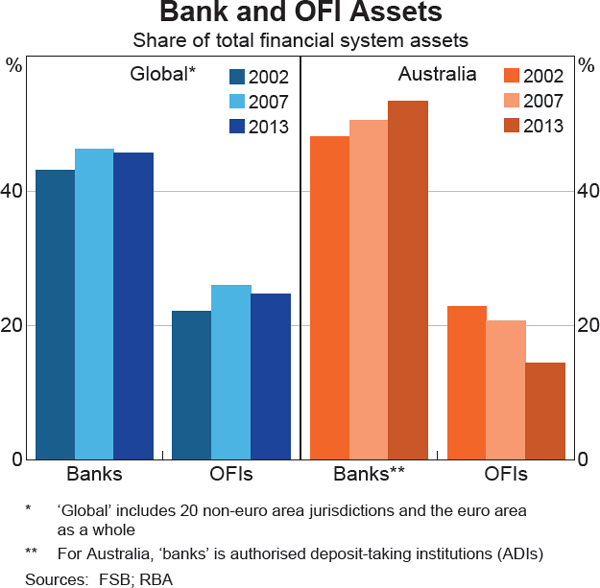
The FSB has also begun publishing a narrower measure of ‘shadow banking’, which endeavours to isolate OFIs' assets relating to credit intermediation. The FSB considers this ‘narrow measure’ to be more relevant to financial stability, but the measure is considered a work in progress, partly due to lack of data. Under the narrow measure, the global shadow banking sector is considerably smaller than under the broad measure (Graph 2), but appears similar to its pre-crisis size.[4] Around three-quarters of global assets excluded by the narrow measure are assets held in equity funds (with no direct link to credit intermediation), or are part of consolidated banking groups and therefore subject to prudential regulation.
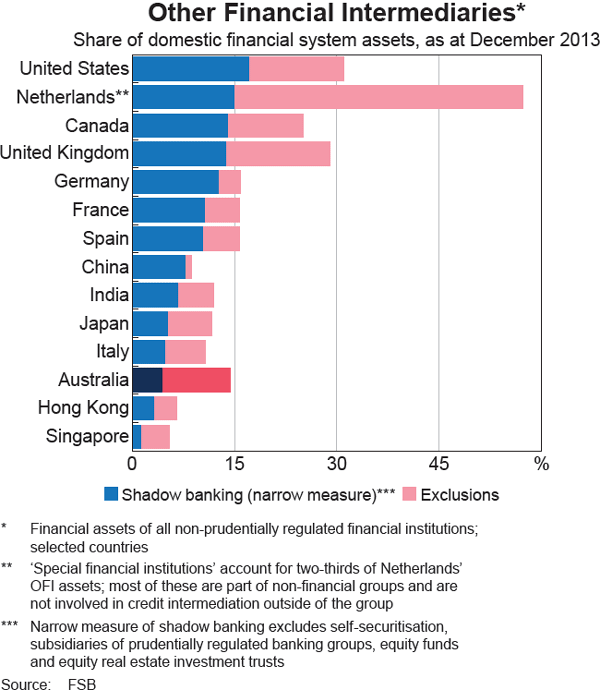
Narrowly defined, Australia's shadow banking sector looks even smaller on an international comparison. The main exclusions from the broad measure are: self-securitisation, which is, by definition, bank-owned and therefore within the prudential net; and equity real estate investment trusts (REITs) and equity funds, which are not bank-like credit intermediation.[5] The sector's share of the Australian financial system is also well below pre-crisis peaks on the narrow measure, having fallen over most of the past seven years (Table 2).[6] A contributing factor is that a number of finance companies and money market corporations (MMCs) – which are the OFI entities most readily considered to be shadow banks in Australia due to their credit intermediation activities – have scaled back their activities or exited the industry over recent years. The ‘other investment funds’ industry – which includes mortgage REITs and cash management trusts (the domestic equivalent of MMFs) – has also contracted since the crisis.[7] Investors may have reduced their demand because they now better recognise the credit and liquidity risks posed by these products. Another driver may be that bank deposits have become more competitively priced than in the past, as well as now being government guaranteed, up to a limit, under the Financial Claims Scheme.
A key lesson from the crisis for regulators globally was that distress in the shadow banking system may be transmitted throughout the broader domestic and international financial system via direct and indirect linkages. In terms of funding interdependencies within the Australian financial system, banks' funding from, and lending to, the OFI sector is quite low and has declined in recent years. Banks' funding from, and lending to, finance companies and money market corporations are equivalent to less than 1 per cent of banking system assets, having fallen over recent years (Graph 3).
| December 2002 |
December 2007 |
September 2014 |
|
|---|---|---|---|
| Total prudentially regulated | 76 | 79 | 85 |
| Banks, credit unions and building societies (ADIs) | 49 | 52 | 55 |
| Superannuation funds(b) | 23 | 24 | 27 |
| Insurers | 4 | 3 | 3 |
| OFIs (shadow banking broad measure) | 24 | 21 | 15 |
| Structured finance vehicles | 6 | 6 | 7 |
| Finance companies | 4 | 3 | 2 |
| Money market corporations | 4 | 2 | 1 |
| Cash management trusts (MMFs) | 1 | 1 | 0 |
| Other investment funds(c) | 8 | 9 | 5 |
| Shadow banking (narrow measure) | 11 | 10 | 4 |
| Excludes | |||
| – Self-securitisation | 0 | 0 | 5 |
| – Equity REITs | 3 | 4 | 2 |
| – Equity funds | 4 | 4 | 2 |
| – Prudentially consolidated assets(d) | 6(e) | 4 | 2 |
|
(a) Excludes central bank assets; totals may not equal the sum of components due
to rounding effects Sources: ABS; APRA; FSB; RBA |
|||
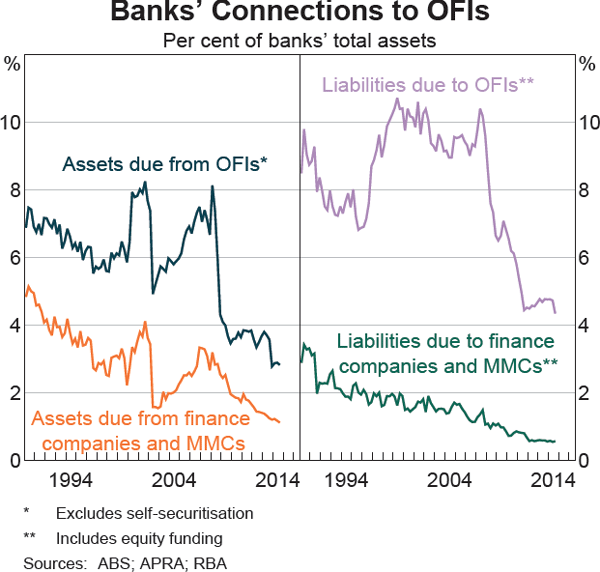
Securitisation and Repo Financing in Australia
Financing activities in securitisation and repo markets have been a particular focus of regulators in the wake of the crisis. These activities span banking and shadow banking markets, though the use of these methods for financing by shadow banks is of particular interest from a risk perspective.[8] Whereas banks are subject to a well-developed system of prudential regulation and other safeguards, the shadow banking system is typically subject to less stringent oversight. As a result, shadow banks are often more reliant on these secured funding methods than prudentially regulated institutions to meet the credit risk tolerance of investors, and are more susceptible to funding pressure if credit concerns arise. This section briefly looks at the securitisation and repo markets in Australia, with a focus on risks arising from their use in the shadow banking sector.
Securitisation
Securitisation, the practice of transforming pools of non-tradable assets into securities that can be traded in financial markets, is a form of non-traditional credit intermediation used by banks and shadow banks. The crisis highlighted numerous examples where securitisation activity resulted in misaligned incentives, often aggravated by opacity and complexity. For example, in the United States a number of banks relaxed their lending standards as securitisation enabled them to transfer credit risk to investors in securitisation products. As became evident during the financial crisis, reliance on securitisation for funding can also expose financial institutions to liquidity pressures when there is a sudden flight to perceived quality, particularly for non-prudentially regulated institutions. In a number of cases, these risks flowed back to the banking system and broader financial system through various interlinkages.
In Australia, non-ADI mortgage originators are the largest non-prudentially regulated issuers of securitised funding. Securitisation activity by mortgage originators can also involve some risk to the banking system via banks providing:
- warehouse facilities, which allow mortgage originators to fund mortgages until they have originated a sufficient amount to issue new securities
- liquidity facilities, which enable structured finance vehicles to meet senior expenses and interest payments on notes in case of a temporary shortfall in income
- a variety of swaps, including interest rate swaps, exchange rate swaps and, most importantly, basis swaps (which convert the variable-rate mortgage interest payments from the collateral pool to floating-rate interest payments linked to money market reference rates).
However, the scale of mortgage originators' activities is quite small, and much reduced since the crisis. Though asset quality of the Australian securitisation market held up well throughout the crisis, there was a sharp post-crisis fall in overall issuance of asset-backed securities (ABS) (Graph 4) as investors avoided the asset class, and mortgage originators' issuance of RMBS declined markedly (Graph 5). Outstanding RMBS issued by mortgage originators accounted for around 1 per cent of Australian mortgages at December 2014, down from 4 per cent at September 2007. Over this period, broader reliance on RMBS has also declined: the share of outstanding Australian residential mortgages funded through securitisation was 8 per cent at December 2014, compared with a peak of 23 per cent at September 2007. RMBS issuance has picked up somewhat in recent years as spreads have narrowed, although the increase has been led by the banking sector; issuance by the major banks in 2014 was on par with their issuance prior to the global financial crisis.
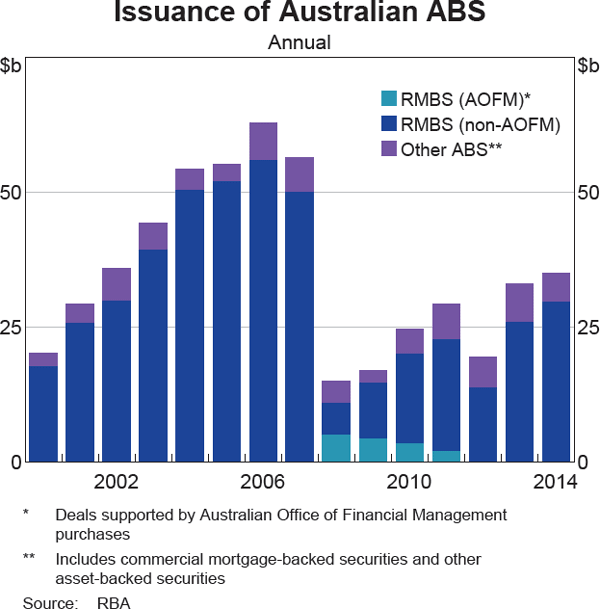
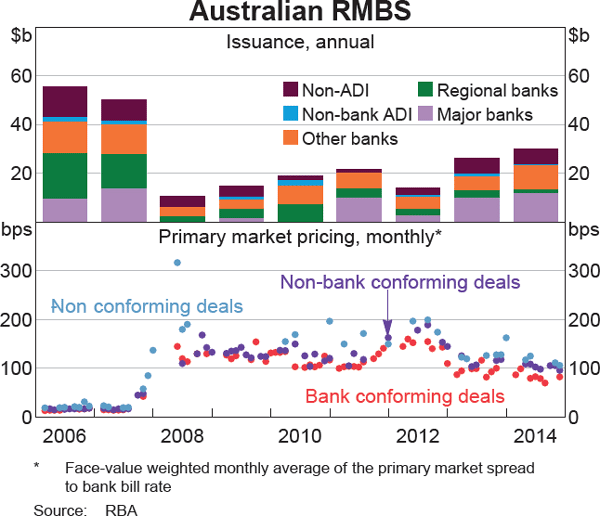
Given securitisation is connected to both the banking system and the housing market, Australian regulators remain alert to potential risks from this activity. Since the crisis, APRA has used its liquidity framework to limit funding risks to the banking sector. If implemented, APRA's proposed reforms to the prudential framework for securitisation should help reduce complexity in issuance by regulated lenders, as well as better align their incentives with those of RMBS investors. APRA has also proposed to limit the concessional capital treatment on warehouse facilities to those of up to one year in duration, which if implemented should encourage banks to hold sufficient capital to cover rollover risks associated with funding warehouse facilities.
Repurchase agreement activity
Repurchase agreements, or repos, are contracts in which the issuing party agrees to sell securities to a counterparty and buy them back in the future at a specified price, thereby providing collateral against the funding obtained. Once again, the crisis highlighted a number of risks arising from this form of financing, including the build-up in leverage and subsequent funding pressures faced by US shadow banking entities – particularly broker-dealers, such as Lehman Brothers.
Using securities lending and repos, entities outside the banking system could potentially create significant system-wide leverage and maturity transformation that is not readily apparent to investors or regulators. In normal times, investors may consider these secured liabilities safe and liquid, but they may be vulnerable to runs in periods of stress if investors worry about the underlying counterparty risk and/or uncertainty about the underlying value of the collateral. These fears can be compounded if: the underlying collateral is of low credit quality; ‘haircuts’ offering protection from falls in collateral value are too low given volatility; and there is uncertainty about whether the underlying collateral will be returned, given the practice of recycling collateral through a chain of repo agreements – a process known as ‘rehypothecation’. Resulting forced sales of assets whose values are already under pressure can accelerate an adverse feedback loop, in which all firms with similar assets suffer mark-to-market losses, which in turn can lead to more fire sales.
As with securitisation, the bulk of repo activity in Australia is within the prudentially regulated sector. Banks dominate the sector, with a large share of these liabilities with the Reserve Bank rather than private counterparties. Repos are a relatively small source of funding for banks, constituting around 3 per cent of total liabilities (Graph 6). These exposures are subject to regulatory scrutiny as part of APRA's overall prudential liquidity requirements. Another factor supportive of repo funding stability is that the vast majority of repo transactions in Australia use high-quality Commonwealth or state government bonds as collateral. The high quality of the collateral pool, which contrasts with some countries where riskier forms of collateral are more prevalent, reduces the potential for credit quality fears and disruptive fire sales into illiquid markets.
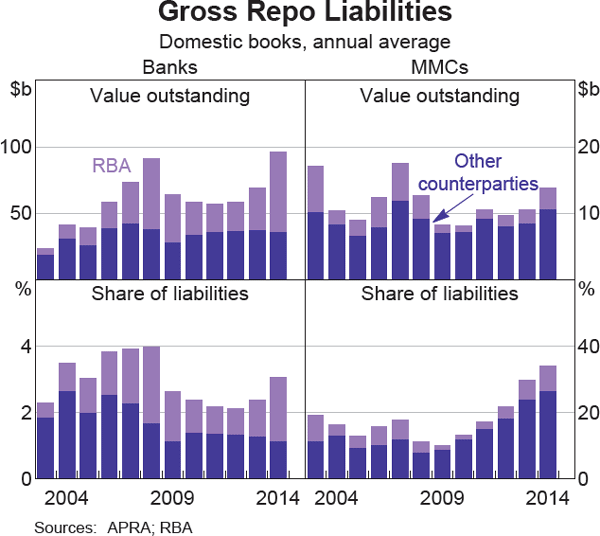
Outside the prudentially regulated sector, MMCs are a major user of repo funding. MMCs operate with higher leverage than banks and are relatively more reliant on repo funding. As explained above, however, size is a factor limiting the systemic importance of these MMCs: they account for less than 1 per cent of the overall financial system and have limited connections with the banking system. In comparison, prior to the financial crisis, US broker-dealers – the closest equivalent to MMCs and heavy users of repo financing – accounted for 5 per cent of US financial system assets.
Consistent with the international reform effort, however, risks from repos are being actively considered by Australian regulators. In March, the Bank published a consultation paper seeking views on the costs and benefits of a potential central counterparty for clearing repos in Australia (RBA 2015). And a CFR working group on shadow banking is, among other aspects, evaluating the case for implementing international standards on securities financing transactions.
Conclusion
Addressing shadow banking risks remains one of the core post-crisis reform areas of international regulators. The FSB's aim is to subject shadow banking to appropriate oversight and regulation to address bank-like risks to financial stability, while not inhibiting sustainable non-bank financing activity that does not pose such risks. One motivation is to ensure that regulatory reforms in the prudentially regulated sector do not result in systemic risks migrating ‘into the shadows’.
The Australian shadow banking sector remains relatively small by international standards, and this should limit potential systemic risk. However, data in this sector are not comprehensive, and there is some potential for aggregate data to mask concentrations and interlinkages that could be problematic in a stressed environment. Australian regulators will remain engaged with international regulatory work in assessing risks and considering safeguards. In line with the FSB's overall objective, regulators need to strike a balance so that the regulatory approach should be proportionate to financial stability risks, focusing on those activities that are material to the financial system.
Footnotes
The authors are from Financial Stability Department. [*]
Public reporting by agencies on these topics includes RBA (2012) and ASIC (2013). [1]
The ‘global’ report includes data from FSB member economies as well as some data on the euro area as a whole. The FSB estimates that this covers around 90 per cent of global financial system assets. Most of the broad measures of the size of the global shadow banking market reflect aggregates for 20 non-euro area jurisdictions plus the euro area as a whole. [2]
Large variation in global growth rates was apparent in 2013. Major advanced economies in the euro area saw negligible or negative annual growth in the assets of OFIs, while Argentina and China saw the strongest growth among reporting jurisdictions at 50 and 34 per cent, respectively. [3]
The measures are not strictly comparable on a global aggregate basis in that the broad measure captures 20 non-euro area jurisdictions and the euro area as a whole, whereas the narrow measure captures 23 reporting jurisdictions. The time series for the narrow measure is currently subject to review, with a number of jurisdictions having changed their methodology in 2013. [4]
Self-securitisation (or retained securitisation) is securitisation solely for the purpose of using the securities created as collateral with the central bank in order to obtain funding, with no intent to sell them to third-party investors. All securities issued by the SFV are owned by the originating bank and remain on its balance sheet. [5]
More detail on post-crisis developments in the shadow banking sector can be found in Schwartz and Carr (2013). [6]
Mortgage REITs generate revenue from holding property-related debt. In contrast, equity REITs invest in and own physical properties. [7]
The International Monetary Fund reviewed various approaches to measuring shadow banking and highlights the different advantages and drawbacks of each approach. One issue their analysis highlights is that some shadow banking activities may be liabilities of a consolidated banking group (and therefore largely outside the remit of the FSB's shadow banking measure), thus emphasising the importance of comprehensive prudential supervision. Securitisation and repo arrangements are discussed in their analysis; see IMF (2014). [8]
References
ASIC (Australian Securities and Investments Commission) (2013), ‘The Australian Hedge Funds Sector and Systemic Risk’, Report 370, September. Available at <http://asic.gov.au/regulatory-resources/find-a-document/reports/rep-370-the-australian-hedge-funds-sector-and-systemic-risk/>.
FSB (Financial Stability Board) (2013), ‘Strengthening Oversight and Regulation of Shadow Banking: An Overview of Policy Recommendations’, 29 August. Available at <http://www.financialstabilityboard.org/wp-content/uploads/r_130829a.pdf?page_moved=1>.
FSB (2014a), ‘Transforming Shadow Banking into Resilient Market-based Finance: An Overview of Progress and a Roadmap for 2015’, 14 November. Available at <http://www.financialstabilityboard.org/wp-content/uploads/Progress-Report-on-Transforming-Shadow-Banking-into-Resilient-Market-Based-Financing.pdf>.
FSB (2014b), ‘Global Shadow Banking Monitoring Report 2014’, 30 October. Available at <http://www.financialstabilityboard.org/wp-content/uploads/r_141030.pdf?page_moved=1>.
IMF (International Monetary Fund) (2014), Global Financial Stability Report – Risk Taking, Liquidity, and Shadow Banking: Curbing Excess while Promoting Growth, World Economic and Financial Surveys, IMF, Washington, DC.
RBA (Reserve Bank of Australia) (2012), ‘Box D: A Closer Look at the Shadow Banking System in Australia’, Financial Stability Review, March, pp 69–72.
RBA (2015), ‘Central Clearing of Repos in Australia: A Consultation Paper’, March.
Schwartz C and T Carr (2013), ‘Shadow Banking: Australian and International Experience around Times of Financial Stress and Regulatory Reform’, JASSA: The Finsia Journal of Applied Finance, Issue 3, pp 30–38.